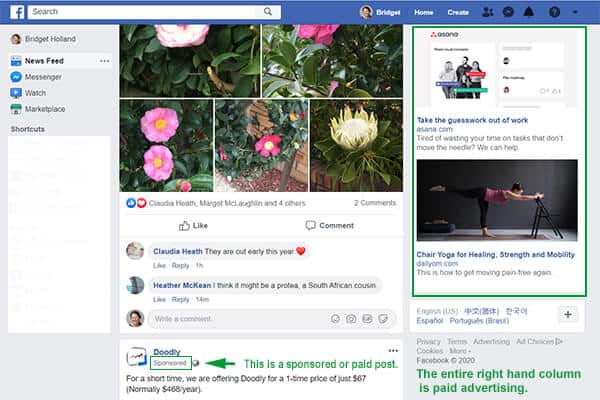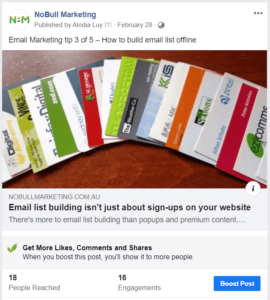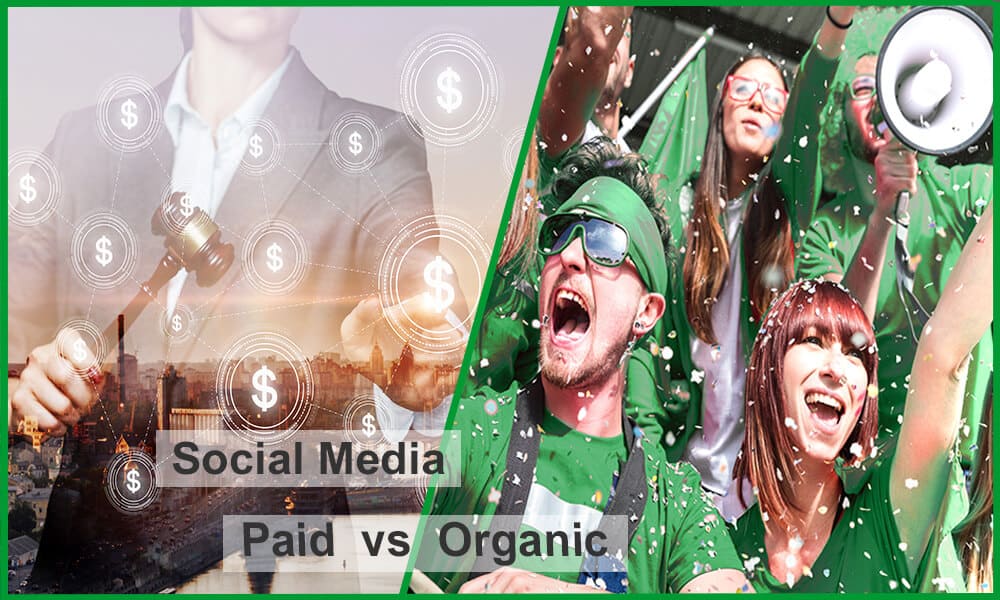I meet many small business people who are keen to use social media in their marketing. Unfortunately, most of them have very little knowledge of how social media works. Some aren’t even aware of the distinction between organic social media and paid advertising campaigns on the platforms. Others are aware there’s a difference, but don’t really understand how marketing goals and results differ for paid vs social organic.
So if you want to use social media in your marketing, make sure you understand how paid and organic social media work. Then you can use them effectively.
(TL;DR: Keep organic social media in-house and focus on your existing contacts. Outsource paid social media to get more new business. For specific tips on how to make each work better, you’ll have to read the full article!)
Understanding how organic and paid social media work
Let’s look at organic social media first – because this is what most business people think of when they hear ‘social media’.
Organic social media is the business equivalent of your free personal account.
You don’t pay to join the platform. You simply create a page for your business, add information, make regular posts and hope people like what you’re putting out there. If they do, you get likes, shares, follows, comments. And hopefully, more visits to your website, sales page, online or real life store, resulting in more business.
Organic social media costs nothing but your time. (Although if you have personal social media accounts, you know how much time they can cost!) But be aware, you reach mostly the people who are already following you – plus some of their connections when they comment, like or share. That network effect is where the term ‘organic’ comes from.
What about paid social media?
Paid social media is about paying the social media platform to show ads to members who are in your target market. Usually, these are people who have no connection with (maybe no awareness of) your business.
It’s a completely different ball game.
So which one should you use first and how should you do it?
Here are my recommendations:
Use organic social media for existing customers and contacts
Having a business page on top social media platforms is first and foremost a way to prove your business exists, is active and is listening. It’s also a way to build and deepen relationships.
As mentioned above, organic social media is primarily for people who know about you already. They are generally your existing customers and contacts. When dealing with these people, very often the goal is to be available if they need you. So some rough guidelines are:
- Make sure you respond to anyone who comments, asks a question or gives you a review. Make them feel loved.
- Post regularly to your business page. This could be daily, every couple of days or weekly, dependent on your industry and your level of commitment. But you want to have enough recent content that your page doesn’t look neglected.
- Sharing to groups can also help extend your reach. Just make sure you comply with the guidelines of the group.
Three tips to make organic social media work better
- Your posts don’t all have to be salesy.
You’re trying to build and maintain a relationship with someone who already likes you enough to visit or follow your page. Photos or short paragraphs about jobs you’ve done are a great option. Humorous quotes and memes can work too, depending on your industry. Or share a testimonial and say how happy it makes you to hear from a satisfied customer. It’s all about putting yourself forward in a favourable light, but not being too pushy. - Since your followers are mostly people who know you, your organic posts need to look and feel like you. You can outsource, but if you do, make sure the content that’s posted matches your business personality and positioning. Also be sure you can justify the cost, since organic social media alone is unlikely to gain you heaps of new business.
- Posting regularly can take a lot of time. It’s easier to batch the process. Create a load of posts at one time, then schedule them to publish over the next week or more. Facebook lets you do this within the platform (see the screenshot below). LinkedIn doesn’t. If you’re using LinkedIn, or if you’re posting to a lot of different networks, you may want to invest in social media scheduling software. (Buffer is simple and has a free plan. Or check out this list for more options.)

Of course if you launch a new product or service, or if you have a special promotion, you want to tell your existing fan base all about it. So post about it to your organic social media accounts.
Just remember, the people who see this post are your existing clients and contacts. If some of them like or comment, their contacts will see that activity. But an organic post on your social media account is not going to reach thousands of new potential customers.
In fact, your post won’t even reach everyone who follows your page.
It will only reach the most engaged of them. The chart below (from Lyfe Marketing in the US) shows what percentage of followers actually see one of your posts.

Why? Because unless you invest in paid social media advertising, the social media platform makes no money out of your business. And they need to make money too.
Use paid social media marketing to reach prospects who don’t know you
Which brings us nicely onto to the subject of paid social media marketing.
Paid social media has some key advantages:
- Social networks know a lot about their members. So it’s possible to target very effectively. Not just the standard demographics, but also which brands people like or follow, their interests, even life events. So if, for example, you’re running a mums’ paleo health program during school hours, you can target women aged 25 to 40 in specific suburbs who have kids aged 5 and over but not younger; who are interested in exercise, and who follow pages about paleo or primal diets.
- The ads are usually well integrated into users’ feeds. They will be seen. You just need to make them stand out and appeal so that people respond.

- Generally, the model is about paying on results. So it’s pay per click, pay per lead, pay per view of a video and so on. If the campaign bombs, you don’t have huge costs. Even if you pay an expert to set up and manage the campaign for you, it’s still far cheaper than print or TV advertising.
(That’s what NoBull Marketing do. We have enough to keep up with across other areas of marketing – we can’t keep up with all of social media too. So we entrust to expert partners. If you want some recommendations, just ask us.)
Four tips to make paid social media work better
- Be really clear who you want to target.
There are plenty of options. Define your demomgraphics, then look at other psychographic or behavioural information. The groups people belong to show their interests. If you’re selling a high price luxury product or service, look for people who follow luxury brands. If you’re seling coaching or self-help, look for people who follow pages in your niche. (You can even target people who follow or like your competitor’s business pages!) - Set a goal which makes a difference to your business.
Likes, follows and shares don’t bring you any revenue. Or leads. They’re not appropriate goals for most small businesses using paid social media.
Consider other options. Sales, if you sell online. Enquiries or requests for a quotation. Downloads or subscriptions which mean you get someone’s contact details and can market to them. - Use an expert to set up and manage your campaigns.
Paid social media advertising is complicated. Most of the platforms offer multiple options for how to advertise. Those options often change. It’s possible to spend a lot of money with little return. A social media expert or agency will charge you a management fee, but they also know what kind of advertising will work best for your business. So you’ll get a better response to your ads, and a better result overall. (Plus, they know the platforms, which can save you hours of time setting a campaign up.) - If you’re using organic social media, use that to find topics and offers which might work well for paid media. For example, the Facebook post below got excellent engagement from the people it reached. It’s a good candidate to boost. Or we could use the topic to create an offer for paid social media.

Summing Up
Whatever platform you use, organic and paid social media are very different animals. If you’ve got the time, budget and inclination, it’s worth doing both. But make sure you know what you are trying to achieve with each channel.
The days of getting lots of new business from organic social media are long gone. It is more a cost of doing business, or a channel for existing customer relationships. And since followers know you, authentic and natural is just as good as picture perfect.
Paid social media offers low risk marketing with powerful targeting capability. But it’s complicated and if you don’t know what you’re doing you can get it very wrong. Consider expert advice and assistance. If you don’t know where to go, ask us who we recommend for your industry and goals.





